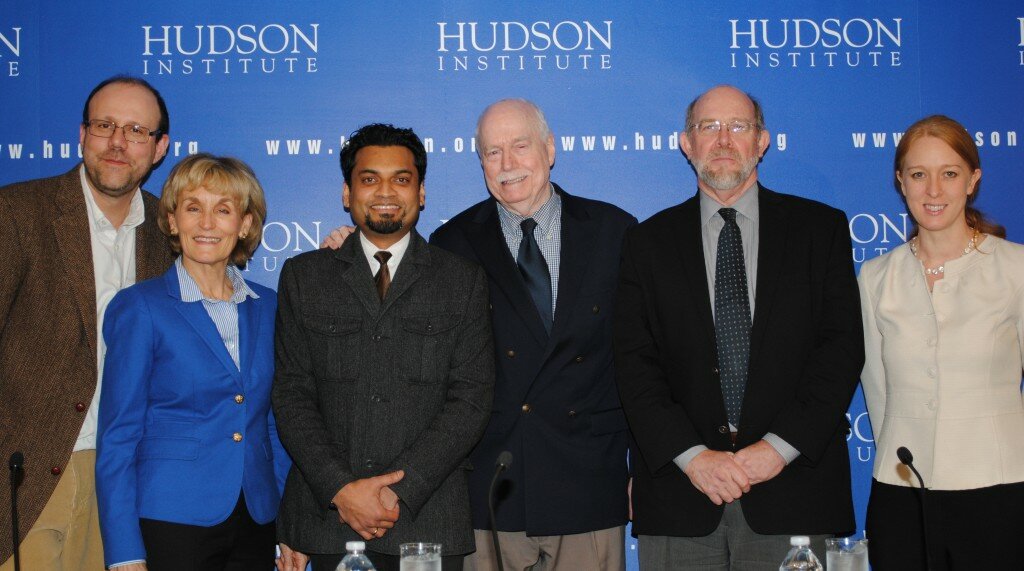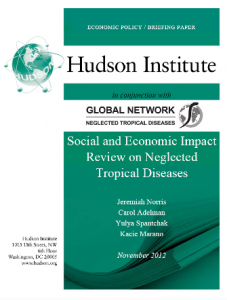A few days ago on the blog we asked, “Why NTDs?”.
NTDs are directly tied to many other global health issues and the impacts of NTD treatment go beyond health benefits. Recently, Hudson Institute’s Center for Science in Public Policy in partnership with the Global Network for Neglected Tropical Diseases, published a new report to highlight the links between NTDs and socio-economic prosperity. The paper found NTD control and elimination efforts to be both inexpensive and highly effective, especially when paired with other major disease treatment efforts, making NTD programs one of the most cost-effective public health interventions available.
Today, Hudson Institute and the Global Network hosted a panel event to discuss the paper’s findings. Dr. Neeraj Mistry, Managing Director of the Global Network, moderated the event, where panelists included:
- Don Bundy, Lead Health and Education Specialist at The World Bank
- Jeremiah Norris, Director of Hudson Institute’s Center for Science in Public Policy
- Ellen Agler, CEO of The END Fund

Panelists at Hudson Institute and Global Network’s launch of “Social and Economic Impact Review on NTDs.”
Photo by Peri Farbstein, Hudson Institute.
Michael Kremer, Gates Professor of Developing Societies at Harvard University, provided the introductory remarks to a packed room, explaining why he, an economist, became interested in intestinal worms. Kremer described his research on deworming and its impact on improving school attendance. He found that students that participated in mass deworming programs as children were more likely to continue their education, have higher wage earnings and contribute to the local economy. These benefits weren’t just observed in school students, but extended to the surrounding community as infection rates fell.
These “positive externalities,” as Dr. Mistry described them, combined with the very low cost of treatment, are what make NTD programs such a good investment in global health.
Yet, despite their wide-spread impact and low treatment cost, NTDs have been categorized as “other diseases” on the global health and development agenda and often exist in the shadow of better-known diseases such as HIV/AIDS, tuberculosis and malaria.
As an example, Jeremiah Norris, one of the report’s authors, described the example of the near elimination of schistosomiasis in Egypt, a triumph in public health practice. This achievement was met with little to no fanfare. Don Bundy echoed this sentiment, by noting that NTDs are diseases of neglected people, the “people beyond the end of the road.”
As CEO of The END Fund, Ellen Agler described how new partners are eager to get on board. For potential advocates and donors, NTD treatment is “an evidence-based, cost-effective, high impact, transformational intervention,” she said.
Dr. Mistry encourag ed participants at the event to get involved in ongoing efforts to control and eliminate these diseases: “We need to make noise, we need to be champions.”
ed participants at the event to get involved in ongoing efforts to control and eliminate these diseases: “We need to make noise, we need to be champions.”
It’s evident that the sea is changing. And more and more people within the global health community and beyond are becoming aware of both the enormous burden of NTDs and the path ahead to controlling or eliminating many of these diseases.
“By following the report’s recommendations, we can build even broader awareness and the political will necessary to put NTDs at the top of the global development agenda—improving the health and prosperity for more than a billion people currently suffering from these devastating diseases,” said Dr. Mistry.
You can read a full version of the report on the Global Network’s website here or on Hudson Institute’s website here. In addition, an archived webcast of the event is available .
